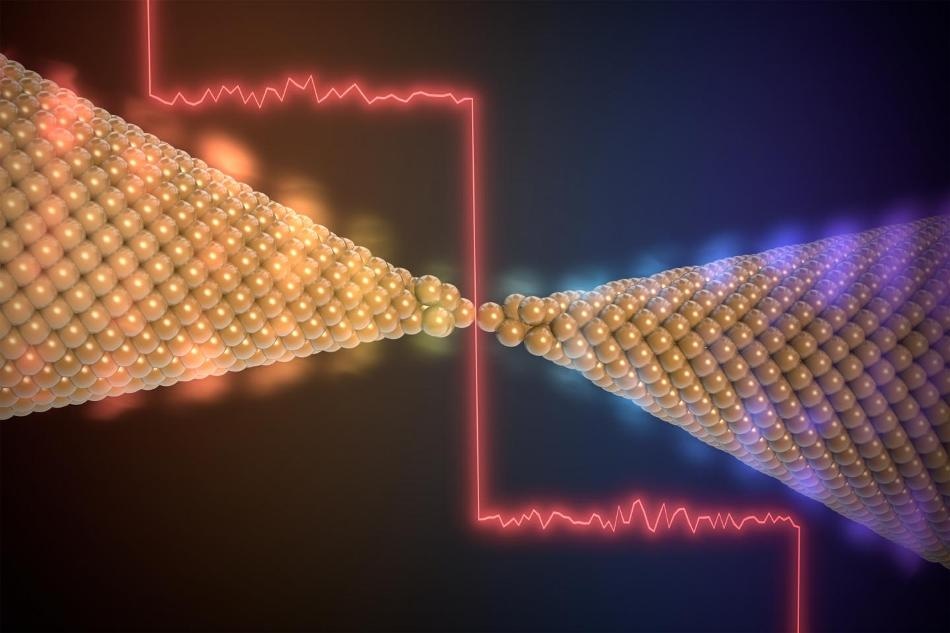Feb 20 2017
 This is an artist�s view of the quantized thermal conductance of an atomically thin gold contact. CREDIT: Created by Enrique Sahagun.
This is an artist�s view of the quantized thermal conductance of an atomically thin gold contact. CREDIT: Created by Enrique Sahagun.
The phenomenon of heat transport is highly significant as its regulation, for example, is inevitable for efficient cooling of smaller chips.
An international research team made up of Junior Professor Fabian Pauly and Professor Peter Nielaba, who are theoretical physicists at the University of Konstanz, and their staff, has made a quantum leap toward in-depth knowledge on heat transport at the nanoscale.
The researchers achieved this by employing a system often used by nanoscience experimentalists and acts as the “fruit fly” for breakthrough findings - a chain of gold atoms. Using the gold atom chain, the researchers explained the quantization of the electronic part of thermal conductance.
In addition, the research demonstrated that Wiedemann-Franz law - a relation from classical physics which states that thermal conductance and electric conductance are proportional to each other - stays valid even down to the atomic level. The outcomes of the research were reported in the 16 February 2017 issue of the scientific journal Science.
Initially, a microscopic gold wire is taken as the test object. The gold wire is stretched up to the point where its cross section is just an atom wide and a gold atom chain is formed, before it gets eventually broken. The researchers passed electric current through the atomic gold chain, which is the thinnest wire ever possible.
Then, they used various theoretical models to predict the electric conductance value. The predicted conductance value was validated by experimental methods. The amount of charge current that flows upon applying an electrical voltage is indicated by this electric conductance. However, for gold chain atomic wires, the thermal conductance - that is, the amount of heat flowing with respect to difference in temperature - could not be measured until now.
Currently, the uncertainty is whether the Wiedemann-Franz law continues to be valid even at the atomic level. In general, heat transport is not only caused by electrons and but also atomic oscillations - vibrations or phonons. In order to explain electron as well as phonon transport, we have to apply quantum mechanics at the atomic scale.
However, the Wiedemann-Franz law explains only the correlation among macroscopic electronic properties. For that reason the physicists first had to discover the contribution of phonons toward the thermal conductance.
Jan Klöckner and Manuel Matt, doctoral researchers, carried out complementary theoretical calculations, which indicated that typically, the phonon contribution toward heat transport in thin atomic gold wires is less than 10%, and not a determining factor.
At the same time, the simulations corroborated the pertinence of the Wiedemann-Franz law. An efficient, but less precise, technique used by Manuel Matt produced statistical results for various gold wire stretching events to compute the electronic part of the thermal conductance value.
While the density functional theory was used by Jan Klöckner to calculate the phononic and electronic contributions in discrete contact geometries. As demonstrated by the experiment, the quantization of thermal conductance in gold chains is eventually due to the combined effect of three factors: the validity of the Wiedemann-Franz law, the marginal role played by phonons in heat transport, and the quantization of the electrical conductance value in units of the conductance quantum, which is equal to twice the inverse Klitzing constant 2e2/h.
Until recently, the theoretical calculation of the ways in which heat and charges flow through nanostructures could be carried out using computer models similar to those developed by the research teams of Fabian Pauly and Peter Nielaba. An exceptionally accurate experimental setup - similar to the one developed by Professor Edgar Meyhofer and Professor Pramod Reddy from the University of Michigan (USA) - was needed to compare the real-time measurements with theoretical predictions.
In the earlier investigations, the signals resulting from the flow of heat through single atom contacts were very minute. The research team from the University of Michigan was triumphant in enhancing the experiment. As a result, the actual signal can now be easily filtered out and measured.
The findings of the research team have enabled the analysis of heat transport in atomic gold contacts as well as other nanosystems. The findings also enable theoretical and experimental investigation of a number of fundamental quantum heat transport phenomena that can aid in the efficient usage of energy, for instance, by taking advantage of thermoelectricity.